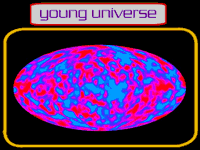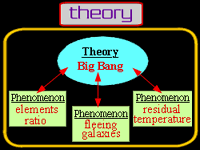- Objective:
To learn about the origin of our universe.
- New Concept:
-
the Big Bang.
- Terms used in this unit:
-
|
-
The universe is expanding. Today, it is larger than it was the past. American astronomer Edward Hubble
discovered this fact in the 1920s. So, what has happened to the universe? What causes the universe to
expand? To answer these questions, cosmologists have come up with several scenarios. Among them,
the Big Bang model -- dubbed as the standard model -- enjoys the most popularity.
|

The residual "fire" of the Big Bang -- a snapshot of the universe at 300,000 years old, imaged by
the COBE satellite. After 15 billion years of cooling, the current
average temperature of the "fire" is about 2.73 degrees Kelvin. The red spots are slightly warmer than the
mean temperature, the blue spots are a bit cooler. The difference between warmer and cooler spots is
about 0.001 percent of the mean temperature.
|
- The Big Bang
-
According to the Big Bang theory, our universe came into being in a violent explosion. Right after its birth,
the universe was extremely hot and its size was much smaller than an atom. Then it began to grow at an
astonishing rate. In just three minutes, the universe had expanded to the size of many
light years across and its temperature dropped to below 1 billion
degrees Kelvin. Fifteen billion years later, the universe formed into what we see it as today -- although the
exact amount of time is still the source of debate among astronomers. The universe is still expanding, but
at slower rate.
|

Fig. 2. Theory vs. Observations. The Big Bang theory has explained many phenomena in
the universe. These phenomena in turn support the idea of the Big Bang. See text for details.
Figure Credits:
NASA, COBE.
|
- Evidence that supports the idea of the Big Bang:
-
If our universe came into being in an explosion and continues to grow as a result of that explosion -- as the
Big Bang theory has suggested -- then:
-
All distant galaxies should appear to speed away from us. This is exactly what
Edward Hubble discovered in the 1920s. This phenomenon is described in the previous unit,
The Expanding Universe.
-
The universe must have a temperature.
This is because right after the Big Bang, the universe had a tremendously high temperature. As it grows,
its temperature cools. After 15 billion years of expansion, the temperature should be rather low but not
zero. This is indeed the case. It has been discovered that our universe still has a temperature of 2.73
degrees Kelvin, just as the Big Bang theory predicted.
-
The ratio of different elements.
In the early days, the temperature of our universe was so high that all matter was melted into a soup of
quarks. The elements were able to form only after the universe cooled to the right temperature. The Big
Bang theory calculates that the ratio of the element hydrogen to the element helium should be about 75
to 25, which is again confirmed by observations.
With support from this evidence, it is no surprise that the Big Bang scenario has been favored by most
cosmologists.
|



